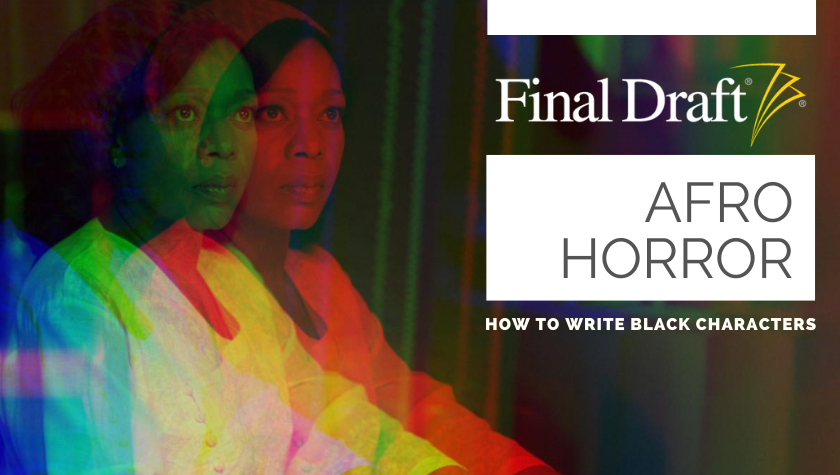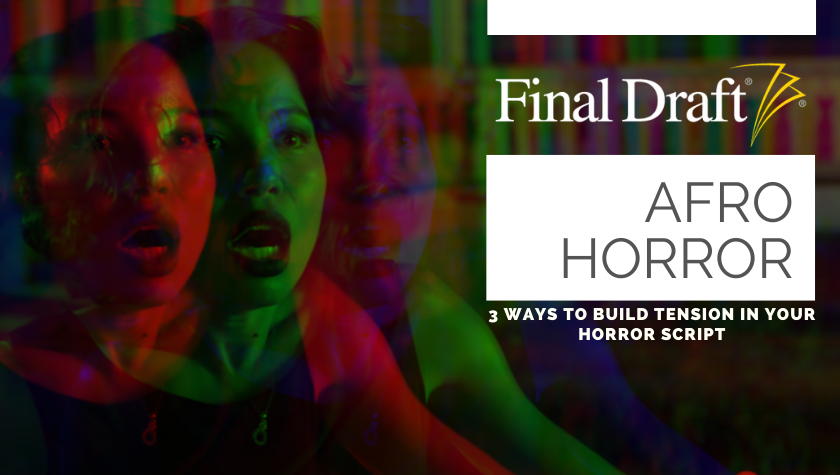Afro Horror: A Recap of 2020's Best Tips For Writing Horror That Thrills
January 15, 2021
It’s a new year, so let’s kick 2021 off right by revisiting some of the tips and rules for the horror genre I've written about in this space. It has been my honor to talk shop with you, so I thought I'd pause for a moment to give you a round-up of my top 2020 screenwriting tips right here and right now, so you can start your new year's project off right.
On writing tension:
CRAFT COMPELLING CHARACTERS. Tension and release only works when the audience actually gives a damn about what’s going to happen with the character. Take scream queen Sidney Prescott (Scream). We care about Sidney. We root for her. No matter how many Ghost Faces she battles, we always want her to evade her killers. But why? In horror, your protagonist, usually a woman, will be your final girl. You’re going to need to take her to hell and back. Imagine if we didn’t care if she lived or died? How flat that would be? How boring? No matter how scary the Big Bad is, if we don’t care about the characters, the story doesn’t work. Spending time in your first act to show us why we need to care about this person is crucial. How are they with their family? Do they have family? Are they a good person? Do they deserve better? Are they a fighter? In 2019’s Ready or Not, an unsuspecting newlywed must survive the night during a wicked game between her new in-laws. Now, what if we didn’t care about Grace, played by the wickedly charming, Samara Weaving? What if she wasn’t this loveable, sweet, funny, kind and the all-around bad-ass bride that she is? We would literally be rooting for her new family to kill her and what kind of tension would that bring? Absolutely none. The tension in Ready or Not is dependent on our connection to Grace. It’s her against everyone else and we root for her to win it all. And — spoiler alert — she does! You need the audience to not necessarily be on your protagonist's side, but you do need them to care about what happens to them.
On writing Black characters:
AVOID AAVE AT ALL COST. SERIOUSLY. What is AAVE, you ask? If I have to define it for you, then you should definitely not be using it. AAVE is African American Vernacular English, aka, slang. It’s typically used by Black people as shorthand speech online, derived from our family. Writing a Black character does not give you free range to impersonate Black people or what you think Black people sound like. We are not monolithic. While AAVE is gaining in popularity online, not all Black people use it. Depending on where you live, the AAVE will change. You can tell when a character is written by a non-Black writer because their speech is usually riddled with AAVE. Just write the character — dassit (AAVVE). Whomever is hired to portray that character will take care of the rest. If your character is described as “hard, tough” there’s no need to make their dialogue sound like what you think a “hard, tough” Black person sounds like. The most you should do is describe the character’s personality and allow the actor to find the voice. Leave your “chile” and “oh, hell nos” in the drafts.
On writing a twist ending:
SET UP, SET UP, SET UP. The key to a great twist ending is the first act. In that time you need to introduce us to compelling characters, build their world, and set up the problem or obstacle. All of this has to be accomplished so that the audience is invested enough in your story to actually care what happens in the third act. My favorite part of watching horror films is the first act. Who are these people? What are they hiding? Who or what are they running from? It’s the first fifteen or so minutes where you get to see the characters outside of the Big Bad which will soon define them, so make sure you carefully craft your first act to be all about your characters and their world.
Those are just a few of my favorite horror screenwriting takeaways from last year. As we head into 2021, there’s absolutely nothing scarier than the news at present, so take the time to live and breathe as best as you can. The page will always be there. Happy New Year!
Written by: Sade' Sellers
Sade Sellers is a screenwriter and producer based in Burbank, California. Originally from Michigan’s capital, Lansing, Sade’ has been working in the entertainment industry since 2009. In 2017, Sade’ was a finalist for Tv One’s Screenwriting competition for her teleplay The Replacement. This achievement motivated the network to hire her as a writer for their upcoming movie of the week event, Deadly Dispatch, which premiered on the platform in the summer of 2019. Through that production process, Sade’ met casting director Leah Daniels-Butler who was in the midst of staffing her production company, 1oneninety5. Sade’ then rose to the role of Vice President of Content Acquisitions and Development and spent the next year learning the ecosystem of film and television development from pitching to production. Using that experience, and bound at home due to COVID-19, Sade’ made a return to her first love, screenwriting, utilizing her free time to write new content. www.sadesellers.com- Topics:
- Discussing TV & Film




